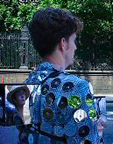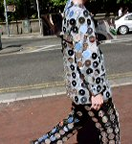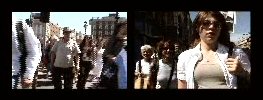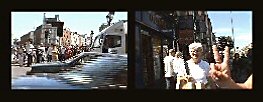September 25, 2006
Robert Ladislas Derr

Two Trace Articles
Chance: a psychogeographical walk performance
by Robert Ladislas Derr, Trace, 17/Jan/2006.
On Thursday, November 10, 2005, beginning at 7:00 pm, I embarked on one of my psychogeographical walk performances. The piece, titled Chance, exhibited at OPENSOURCE (an alternative art space within Champaign-Urbana, Illinois), as part of their exhibition program: Mind in Matter: Constructions of the Built Environment.
For this performance gallery viewers determined the direction of my walk based upon the roll of a dice. Waiting outside the gallery, I received my first command to 'spin' via a two-way radio. The dice indicated that I move forward, backwards, right, left, spin, or stand in place. When 'spin' or 'stand in place' were the command, I completed each for one minute. The directional commands took me to the next intersection, where I awaited another command. The walk continued for thirty minutes.
Just as in past performances, I wore a mirrored suit to allow my presence on the street to be real and illusionary, but this time I had four video cameras attached to my person, recording simultaneously the front, rear, and side views of my journey. Using the city as a fluid canvas, I moved through the streets in silence, capturing the ephemeral characters that constructed the ambiance of place and time. The videos were on display in the gallery, shown split screen.
To accentuate the dichotomy of the mirrored suit, there were two walls of mirrors in the gallery that created the cartography of the performance. Each of the six commands was represented by thirty columns of six mirrors - thirty columns for the thirty minutes of the walk. The gallery viewer rolled the dice and my assistant radioed to me the direction I must move.
Then, according to the time frame of the walk, the assistant removed the number of mirrors that corresponded to the command from the column that corresponded to the number of minutes into the performance, then hung the mirrors on an opposing wall. One wall created the cartography of the walk in the positive and the other in the negative. When the gallery viewer stood between the two walls of mirrors (that had an oscillating presence of real/illusionary, physical/metaphysical, inside/outside, and visible/invisible) the dichotomy of the cartography of the performance was highlighted.
In my psychogeographical walk performances, I am interested in the chance interaction between pedestrians and myself. However, in Chance, not only was interaction with pedestrians emphasized, but also interaction with gallery viewers. This was crucial for my progression. I relied on the viewers to determine the direction of my walk, subverting the traditional social structure of the gallery system that prefers viewers to be quiet observers. Without the viewers, I would have remained stationary for thirty minutes
Through my self-induced spectacle walk performances, I try to raise awareness of the individual in society. The concept of community is formed on the foundation of the importance of the individual. A community is strengthened by its cultural diversity; each individual resident plays an important role in creating the fabric of a city. Moving through the streets in Champaign, IL by rational and irrational means, walking in silence through the crowd, letting my cameras record, I captured an unedited glimpse of an unfolding drama. Just as Henri Cartier-Bresson captured his decisive moments with the photograph, my video cameras recorded many decisive moments in the framework of linear time, capturing the banality of existence between these moments.
View Quicktime movie clip provided for trAce by Robert Ladislas Derr. Please be patient while movie loads.
Editor's Note: article written in collaboration with Lynn Foglesong-Derr.
Robert Ladislas Derr has exhibited his artwork at museums, galleries, and festivals throughout the United States and abroad. Derr’s artwork has been reviewed by such publications as The New York Times, trAce Online Writing Centre, and Block Magazine. He has lectured about his artwork at such institutions as the Victoria Independent Film & Video Festival, Pre/amble: Festival of Art and Psychogeography, and Society for Photographic Education. Derr has been a recipient of a number of grants, fellowships, and awards including an Individual Artist Fellowship from the Ohio Arts Council and stipend from the Lower Manhattan Cultural Council (New York, NY). Combining photography and new media, his installations are derived through public and intersubjective performances. It can be said that he often times puts himself literally in the center of a barrage of questions about life and making art. Derr received his MFA from the Rhode Island School of Design and BFA from the Art Academy of Cincinnati. He is an assistant professor and coordinator of the photography area in the Department of Art at The Ohio State University.
Links
Robert Ladislas Derr:
http://www.portfolios.com/rlderr
OPENSOURCE:
http://opensource.boxwith.com
Henri Cartier-Bresson:
http://www.henricartierbresson.org
trAce links
VOID: walking with Ulysses:
http://trace.ntu.ac.uk/Review/index.cfm?article=132
Data and Narrative: Location Aware Fiction:
http://trace.ntu.ac.uk/Opinion/index.cfm?article=83

VOID: walking with Ulysses 1 by Susan Sakash, Trace, 23/Mar/2005.
A man, bedecked in a mirrored suit and wielding two video cameras strapped to his chest and back, moves in regulated sync with traffic signals and pedestrian flow through the city of Dublin. The mirrors place the man in a mobile aura of bouncing reflections. His gaze is fixated on the path in front of him; he does not make eye contact with the passersby who turn to stare after his receding figure. As his path abandons major tourist avenues, he is approached by a man who tries to engage him in conversation, saying that he is a reporter for a major Dublin newspaper. He is supposedly covering the Bloomsday activities and wants to know if this performance is part of the festival. The artist's gaze retains its focus on the intersection ahead. Mirrors do not speak back.
For four consecutive days in June of 2004, Robert Ladislas Derr engaged in VOID, a peripatetic performance, recording the dynamic movements of the city of Dublin via two video cameras mounted on his person. As Derr moved from the residential Mountjoy Square to McKenny bridge crossing the canal at Lower Mount Street, the cameras captured the reactions of fellow pedestrians as they alternated between observing and being observed. The video footage was subsequently shown later each day in a dual monitor installation at the Irish Film Institute in the Temple Bar Cultural Quarter of Dublin City Centre. Both the performative and documentary elements of VOID indicated Derr's desire to explore the conceptual duality of presence and absence, visibility and invisibility of the body's relationship to society.
VOID was one of 19 projects comprising the 2 week Wandering Rocks, Revolving Doors public art exhibition, part of the larger ReJoyce Dublin 2004 Festival celebrating the centenary of James Joyce's Ulysses. Each project evolved out of the artists' individual readings of Wandering Rocks, the 10th chapter of that book and one which is divided into 19 sections shaped by the actions and conversations of a number of minor characters as they wander through the streets of Dublin between the hours of 2:40 and 4:00pm on June 16, 1904. In recording these moments of minutiae, Joyce succeeded in creating a remarkable portrait of the city as it existed at the turn of the century.
Behind the conceptual underpinnings of the Wandering Rocks, Revolving Doors collective was my intention, as creative director and curator of the exhibition, to solicit public art works from an international network of artists that would propose new ways of interacting with Joyce and the city of Dublin in a fashion that still encouraged people to reflect on the movements and patterns of the city in both its historical and contemporary contexts. The event was situated somewhere outside the continuum that has seen the definition of public art move from the site-specific, static monuments of late modernism to the community-specific, socially engaged collaborations of the 90s. Built into Wandering Rocks, Revolving Doors conceptual framework was the idea that participating artists be relative strangers to the city of Dublin, familiar only with the city through Joyce's fictionalized descriptions. To respond to the city as depicted in Ulysses is to respond to a contemporary non-site, razed or buried beneath layers of urban regeneration.
Given the difficulty in defining a specific audience for this event and awareness on behalf of the artists that any attempts to create "community-specific" projects would be presumptive and inevitably isolate the very communities WrRd hoped to engage, artists adapted a variety of strategies. For VOID, Robert Ladislas Derr, whose video/performance pieces often echo the preoccupations of conceptual artists such as Vito Acconci and Lucas Samaras, sought to engage Guy Debord's "society of the spectacle." Rather than adopting the role of spectator, Derr attempted to become the spectacle himself. In Derr's own words:
Reflecting my surroundings, the mirrors created my void as I disappeared in the reflections from the city ... However, the reflections also created my presence ... the suit did more than emphasize my absence and presence, it made me a spectacle.

For Debord, the spectacle was "the autocratic reign of the market economy" and the colorful but empty gestures of those enlisted to divert attention from this accumulation of power. Correspondingly, Derr's suit of mirrors, dancing in the midday light, served to distract viewers from the subtly concealed video cameras he had installed inside mirrored boxes mounted from his shoulders. Like a media circus which reinforces the status quo it is meant to question, the actual spectacle of Derr's person is absent from the project's end product, namely the front and rear video footage recorded on his walks. Here, VOID becomes a subtle inversion of the domination of the spectacle: the ridiculous metaphor of the mirrored suit is but a means towards an end.
What is the end, then, that Derr had in mind? In pre and post event statements alike, Derr was preoccupied with the exploration of self through interaction and engagement with the other. He sought to render his own body as a kind of document of the city, exploring the patterns of habits and chance that lend shape to the specific life flow of a city. Again in Derr's words:
The walk becomes a study into psychogeography, where the geographic features of a city create similitude in daily life. The videos ... reflect my physical experience as I for example, step off the curb to cross the road at relatively the same time each day. My four-day repetitive walk mimics the routine of life.
Coinciding with the habitual patterns of city dwellers is the uncertainty of unanticipated encounters and discoveries: unknowns that add color and variety to our lives.

Derr's footage is testament to this interplay of repetition and surprise. As he travels the same route for four consecutive days at the same hour each day, the sights and basic patterns of the traffic may be similar but it is the particulars that demand attention. A man distractedly eating an apple at a traffic light, the impromptu dance performance of an overweight teen, a graphic oral display by a woman leaning out a pub - it is the "other" who replaces the artist as the director and actor of the unfolding drama. This celebration of minor characters, and the coincidence of habit and chance, emerge as central concerns for the artist, and were also omnipresent throughout Joyce's writing of Ulysses.
Derr's project, like many of the other participating components of WrRd, was careful to avoid responding to Joyce in a way that could be boiled down to mere mimicry of Ulysses. Specifically the path Derr chose to follow during VOID was not a literal retracing of any one character's travels during the Wandering Rocks chapter but rather a collection of movements and journeys. The parameters he set for himself before arriving in Dublin also allowed Derr's cameras to capture the contradictory elements of contemporary Dublin which lay subdued by the nostalgic, tourist-oriented, overtones of the ReJoyce Dublin festival. Rather, the footage poignantly evokes Guy Debord's call in his Introduction to Critique of Urban Geography for artists to observe:
... the sudden change of ambiance in a street within the space of a few meters; the evident division of a city into zones of distinct psychic atmospheres; the path of least resistance which is automatically followed in aimless strolls (and which has no relation to the physical contour of the ground); the appealing or repelling character of certain places.
It is interesting to note that, if we follow the ideological ambitions as set out by the psychogeographists, video art evolved as a reincarnation of their efforts to subvert spectacular displays of those in positions of power. Its affordability and accessibility as a recording device led video to be embraced by the early generation of video artists as a tool offering liberation via the imitation of society's habitual motions. The spectacle, they hoped, when turned back on itself, would implode.
At various stages throughout the development and realization of Derr's project, I was reminded of the ubiquitous presence of the closed circuit cameras that monitor public space throughout Dublin City Centre. Long a source of inspired indignation for multimedia artists, CCTVs' and their Big Brother associations, have proliferated in Dublin alongside the influx of capital and construction. Both CCTVs and the concealed cameras of VOID are to be viewed as tools of surveillance, their footage serving as archival documents. Closed circuit cameras are installed in static locations, meant to safeguard private property by recording the movements and actions of the unawares. While Derr's cameras were also recorders of the movements and actions of the unawares, their mobility canceled their effectiveness as agents of the spectacle.

What differentiated Derr's surveillance technique from that of storeowners and city officials was that, in placing the cameras on his person, his surveillance of fellow pedestrians was no longer anonymous. Though the artist was physically absent on video, his authorial presence could always be intuited, evidenced in the faces and reactions of those recorded. Despite setting parameters, such as obeying all traffic symbols and refraining from conversation, to create the impression of objective documentation, Derr nevertheless produced a very human artwork.
Derr ended each day's performance of VOID on a small bridge crossing the lower canal. Solitary and stationary at last, the artist stood facing west, eyes still focused on the horizon. Meanwhile the footage captured, in its closing moments, images of the canal's mirrored surface. Though this scene retains its familiar composition, one is acutely aware that the water flowing beneath is, like the city it courses through, in a state of flux. The waters wink back at the cameras, recording their own ephemeral impressions at the edge of a historic city.
Since its realization and presentation in Dublin, VOID was recently exhibited in early February 2005 at Technology in the Life World at Open Space, Victoria, Canada, curated by Julie Andreyev as part of the Interactive Futures conference. Most recently, Derr was asked to exhibit and present VOID at the New School Graduate Faculty's conference on Words, Images, and The Framing of Social Reality in mid April.
VOID has influenced Derr's current video performance project American Sites. A multi-year research project, American Sites explores issues of place in the landscape, as a selected and constructed text. Wearing four cameras capturing four simultaneous views of the cardinal directions, Derr will investigate approximately thirteen geographic places across the US that experienced a significant event in U.S. history. Tracing the routes of Paul Revere's ride through Boston and President Kennedy's assassination in Dallas, Texas, American Sites will record and retrace past events infused with historic and personal memory. Like VOID, Derr's physical person will be visually absent, however the four-parameter views will still pick up the presence of his body in motion, thus creating and reinforcing the void.
View Quicktime movie clip provided for trAce by Robert Ladislas Derr. Please be patient while movie loads.
Susan Sakash is a curator and arts administrator fascinated by the ways in which humans create communities with fellow human beings as well as their animate and inanimate surroundings. Most recently, she was the Creative Director of the 'Wandering Rocks, Revolving Doors' public art exhibition in Dublin, Ireland (June 2004) and participated as organizer/artist in eXpuestos, a month long series of public art interventions in Panama City Panama (March 2004). Currently living in Boston, Massachusetts (USA), Susan is co-curator of public art programming at the Berwick Research Institute, an artist-run non-profit that provides alternative programming and exhibition space for artists who work outside the commercial world.
Links
Robert Ladislas Derr:
http://www.portfolios.com/rlderr
Archival documentation of Wandering Rocks, Revolving Doors:
www.newgroundcenter.org/WrRd
Guy-Ernest Debord, The Society of the Spectacle:
http://library.nothingness.org/articles/SI/en/pub_contents/4
Psychogeography:
http://www.psychogeography.org.uk/
Generative Psychogeography:
http://www.socialfiction.org/psychogeography/
Julie Andreyev:
http://www.eciad.ca/~jandreye/
trAce links
Data and Narrative: Location Aware Fiction:
http://trace.ntu.ac.uk/Opinion/index.cfm?article=83
Interactive Futures: New Stories, New Visions :
http://trace.ntu.ac.uk/Review/index.cfm?article=60
New Media Conferences: A Curator's View:
http://trace.ntu.ac.uk/Process/index.cfm?article=75
Posted by jo at September 25, 2006 04:05 PM
